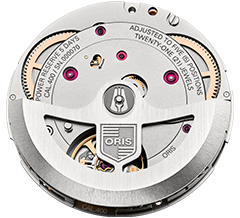MOVEMENTS
CALIBRE 400

MOVEMENT
Automatic winding date developed by Oris
- NUMBER Oris 400
- DIMENSIONS Ø 30.00 mm, 13 1/4’’’
- FUNCTIONS Centre hands for hours, minutes and seconds, date window, instantaneous date, date corrector, fine timing device and stop-second
- WINDING Automatic winding
- POWER-RESERVE 120 hrs
- VIBRATIONS 28’800 A/h, 4 Hz
- JEWELS 21
INNOVATIONS

The new standard
Calibre 400 is an entirely new movement, independently conceived by Oris, and sets the new standard for automatic mechanical movements. It has a five-day power reserve (120 hours), is highly resistant to magnetism, and comes with 10-year recommended service intervals and a 10-year warranty.
Five-day power reserve
When conceptualising Calibre 400, Oris’s engineers recognised that these days we may not wear the same watch every day. If you put a standard mechanical watch down for a day or two, it will stop as the power reserve runs down. Calibre 400 has a five-day power reserve, so it’ll still be running if you’ve not worn your watch between, say, Thursday and Tuesday. It delivers this longer period of use via twin barrels, both of which house an extended mainspring, each long enough to store two-and-a-half days of power. It’s highly accurate, to -3/+5 seconds a day, better than a chronometer.


10-year warranty and recommended service intervals
Oris is so confident in the performance of the advanced technologies integrated into Calibre 400 that we are offering a 10-year warranty on all Oris watches powered by the new movement when you register them at MyOris. In addition, Oris is also proposing 10-year recommended service intervals on Calibre 400 watches. This means that barring accidental damage or waterresistance checks, you shouldn’t need to bring in a Calibre 400 watch for a service until 2030 at the earliest. This is the new standard.
A more stable rotor system
One of Oris’s fundamental ambitions with Calibre 400 was to eliminate problems before they occur. Oris’s engineers identified that one of the most frequent issues with automatic mechanical movements concerns the ball-bearing system that allows the free-spinning oscillating weight (or rotor) to rotate. This is a critical element of an automatic watch – as the rotor spins, it generates power that’s stored in the mainspring, which is housed in the barrel. So we removed the ball bearing altogether and replaced it with a low-friction slide bearing system, in which a metal stud runs through a lubricated sleeve. This is much less complex, highly efficient, and involves far less wear and tear, making it less prone to breakdowns.


Elevated resistance to magnetic fields
Most Swiss watch movements will be magnetised if exposed to the strong magnetic forces we encounter in daily life. When this happens, they become less accurate, and can stop altogether. To make it highly antimagnetic, Oris engineered Calibre 400 using more than 30 non-ferrous and anti-magnetic components, including a silicon escape wheel and a silicon anchor. In testing by the renowned Laboratoire Dubois, Calibre 400 deviated by less than 10 seconds a day after exposure to 2,250 gauss. For context, the latest version of the ISO 764 standard for anti-magnetic watches requires that to qualify as anti-magnetic, a watch must be accurate to within 30 seconds a day after exposure to 200 gauss. Calibre 400 recorded one third of the deviation allowed after exposure to more than 11 times the force permitted, making it a highly anti-magnetic movement.


